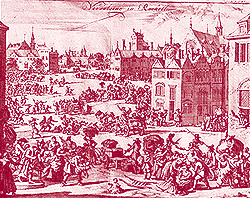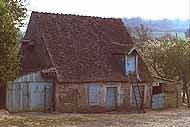Discovering New France
Disappeared, New France? Not so! The traces left behind may not be immediately
obvious, but you only have to listen carefully to observe that it is still alive. First of
all in the French spoken in the former Acadie, Québec, Louisiana and all over Canada in a
language that still sprinkles its speech with words from times past. Then, in the names
given to places, roads and in the establishments encountered on the territory that
belonged to it.
Extinct, New France? A journey along those roads explored and inhabited by the
pioneers allows you to meet the men and women who are watching over a unique heritage.
Yesterday's emigrants loved wide-open spaces; their heirs still maintain contact with the
outdoors and nature in the wild. The pioneers of New France loved festivities and popular
gatherings; their descendants, even more so, enjoy convivial get-togethers and festivals.
The French of the old days evoked with nostalgia the food of doulce France ; French
America maintains a welcoming tradition and has built its own reputation for savoury
dishes.
In ruins, New France? Not so certain! The archaeologist gathers artifacts and
remains. The historian studies the routes that people took. Museums safeguard their works
both great and small. Libraries and archives preserve the documents that bear witness to
the evolution of the first French society in North America. In the cities as much as in
certain isolated sites, reminders still exist, though rarely intact. Carefully
reconstructed, they allow us to imagine the context of everyday life.
From Saint-Malo to Québec
The Virtual Museum of New France's first tourist route is a concise guide. Some
addresses, both essential and non-virtual, lead to France, Québec and Montréal.
The history of New France has a beginning. Let us join the fishermen and sailors from
Saint-Malo. Let us follow Jacques Cartier into the gulf and valley of the Saint Lawrence.
Let us observe the birth of the French institutions of Québec and Montréal. Let us see
the settlers from Perche sign the deed that pledges them to spend several years or a
lifetime in New France. While we are awaiting the hour of departure, let us visit La
Rochelle and its port. Let us salute the work of these men and women, visible in the
streets, towns and museums.
In France
Fécamp: Musée des Terre-Neuvas et de la pêche
A collection of model fishing boats and pictures showing the activities of these «New
Worlders», these sailors from Haute-Normandie who went to fish for cod as far away as
Newfoundland.
La Rochelle: Musée du Nouveau Monde
The collections in this museum bear witness to the vitality of the French in North
America. The visit revolves around two large avenues. One is concerned with the maritime
and colonial business of La Rochelle with French America. The other highlights the North
American dream as it is translated into the works of artists and writers at the end of the
18th century. In the east wing of the museum the subjects are the Amerindians and Canada
in the 17th century.

Illustration: Photo by Charles Danay.
Waiting to board ship; a scene of daily life around the seaport of La Rochelle in the
17th and 18th centuries.
Saint-Malo: Musée d'histoire de la ville de Saint-Malo
On four floors, the museum presents numerous objects and documents on the history of
the town and the position it held in the areas of business and shipping. The life of
Jacques Cartier and his contribution to the discovery and exploration of the gulf and
valley of the Saint Lawrence are abundantly covered.
Tourouvre: Musée de l'histoire de l'émigration percheronne au Canada
An exhibition room in the town hall of this town of Perche is devoted to a
reconstruction of the place where several Percheron people signed their contract of
commitment to Canada. Often this moment was enacted in a public room in Tourouvre, hôtel
du Cheval Blanc. Thematic tableaux describe the motivation and the circumstances
surrounding the departure of the Percheron people.

Illustration: Photo Charles Danay.
Toussaint Giroust was born in 1633 in this old house of Réveillon-au-Perche, in
Normandy. His descendants populated many parts of North America bearing the Giroux
surname.
In Québec
Québec: Cartier-Brébeuf, a national historic site.
The collection assembled in this museum is concentrated around the voyage made in 1535
by Jacques Cartier when he was exploring the Saint Lawrence River. It includes a full-size
reproduction of an Iroquois longhouse and La Grande Hermine, one of the ships commanded by
Jacques Cartier. Here, the meeting between the European and Amerindian cultures of the
16th century is highlighted as well as the establishment of the first Jesuits in New
France.
Québec: Musée des Augustines de l'hôpital général de Québec
This museum has a permanent exhibition of works of art and household and medical items
tracing the history of the first hospital in America north of Mexico. The monastery and
the vaulted cellars date from 1695.
Québec: Place royale
You can walk the streets of Place Royale, located on the edge of the port of Québec.
The square is made up of a large number of houses built in the 17th and 18th century, most
of which have been restored. There is a study centre where archival documents and thematic
studies are available.
Lachine: National landmark : the fur trade in Lachine
The rise of New France was closely associated with the fur trade, a commercial activity
that initiated many explorations to the northern, southern and western regions of
present-day Québec. This centre recounts this epic time and shows many artifacts
associated with it.
|

